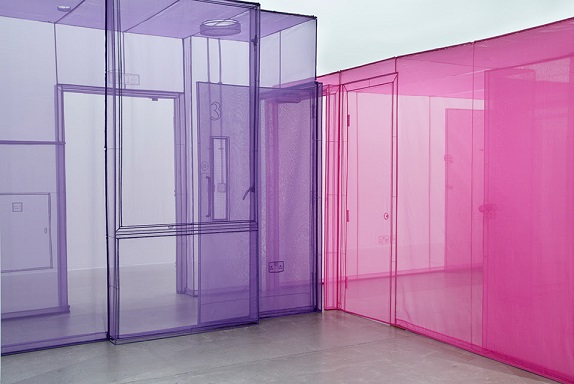정준모
South Korean artist Do Ho Suh shows poetic passages made in fabric at ARoS Aarhus Art Museum

Installation view, Do Ho Suh: Korridor at ARoS Aarhus Kunstmuseum. Photo: Maja Theodoraki.
AARHUS.- A visually seductive exhibition calling for interaction. South Korean artist shows poetic passages made in fabric from his homes in Seoul, Berlin, and London.
Do Ho Suh is known worldwide for his almost weightless transparent spaces made of fabric, accurate and full-size renditions of the homes he has lived in. The exhibition is the third in the "Intermezzo" series of art where the individual artworks are perceived and appreciated through more than just the faculty of sight. This is Do Ho Suh’s first solo exhibition in Denmark.
Do Ho Suh’s story is universal. Most people have experienced leaving one home and setting up another somewhere else. His works capture the particular feeling that can arise in connection with moving house. This is universal and isn’t always easy to put into words. Do Ho Suh’s work is relevant in a world where migration is becoming increasingly widespread and where there is a higher likelihood of people moving away from their original homes, says Erlend G. Høyersten, museum director, ARoS.
In the white-painted gallery space, a 30-metre-long colourful sculptural installation gradually takes form. The installation is made of eight hand-sewn fabric passages connected end-to-end, so that people can walk through them from one end to the other and be enveloped in colourful translucent fabric.
Each space is meticulously hand-sewn using traditional Korean techniques, accentuating the architectural lines and small details such as door handles, brackets, and electrical sockets. Each individual passage is deeply personal and special to Do Ho Suh, as they are "casts" of corridors, passages, and hallways from the homes where he has lived in Seoul, Berlin, and London, respectively. To Do Ho Suh, the movement from one (fabric) space to the next becomes a symbol of his own journey from country to country or from one phase of life to the next.
The exhibition is both visually seductive and calls for interaction and movement. With his fabric sculptures, Do Ho Suh has discovered a unique and poetic way to bring along with him the familiar framework of his home(s) in a portable form that can be "pitched" like a tent when the need arises to sense the calming embrace of a home, says Jeanett Stampe, curator, ARoS.
Do Ho Suh was born in 1962 in Seoul, South Korea. Aged 29, he moved to the USA where he trained as a painter at the Rhode Island School of Design, later studying sculpture at Yale University. At present, he lives and works in London. Do Ho Suh has shown at many international solo exhibitions and his works appear in many museum collections worldwide, including the Museum of Modern Art, New York, the Whitney Museum of American Art, New York, and the Tate, London. Do Ho Suh is represented by Lehmann Maupin, New York, Hong Kong, Seoul, and Victoria Miro, London / Venice.
Do Ho Suh primarily works with sculpture, but his works also include two-dimensional works and films. He is fascinated by elements that give a sense of home, how we store the architecture of the home in our memories, and how the emotional aspects of these spatial experiences can be translated into visual language. Do Ho Suh is best known for his spectacular translucent fabric sculptures which reconstruct spaces on a 1:1 scale. His works spring from his own migratory history and experience of moving from South Korea to the USA and, later, to Europe. His personal life story, on which his works are based, is translated, via these sculptures, into a universal entity that everyone can relate to.
A richly illustrated catalogue will be published to accompany the exhibition and features, besides an introductory text by the exhibition curator Jeanett Stampe, curator, ARoS, an essay by Carsten Thau, professor at the Royal Danish Academy of Fine Arts, School of Architecture.
FAMILY SITE
copyright © 2012 KIM DALJIN ART RESEARCH AND CONSULTING. All Rights reserved
이 페이지는 서울아트가이드에서 제공됩니다. This page provided by Seoul Art Guide.
다음 브라우져 에서 최적화 되어있습니다. This page optimized for these browsers. over IE 8, Chrome, FireFox, Safari